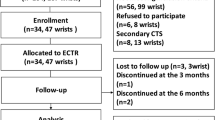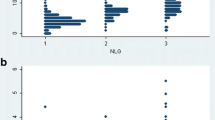Abstract
Introduction
Ultrasound measurement of the cross-sectional area (CSA) of the median nerve can give information about regeneration of the nerve after carpal tunnel release (CTR), but the changes at selected follow-up points up to 1 year compared to electrodiagnostic findings are not known. We postoperatively measured the CSA of the median nerve with ultrasound and compared the measurements with electrophysiological findings over 12 months after open CTR.
Materials and methods
In 21 hands that underwent open CTR, the CSA of the median nerve was measured at the inlet (proximal CSA) and outlet (distal CSA) of the carpal tunnel at 3- 6- and 12-month follow-up. The respective ratios [(CSA postoperatively/CSA preoperatively) × 100] were calculated and correlated with distal motor latency (DML) and sensory nerve conduction velocity (SCV).
Results
The proximal CSA ratio was 88.9, 84.5, and 78.4 % at 3-, 6-, and 12-month follow-up, respectively. Each value was significantly lower than that before surgery. The distal CSA ratio was 104.3, 99.1, and 91.8 % at 3-, 6-, and 12-month follow-up, respectively. The values were not significantly different compared to preoperative values.
Conclusions
The proximal CSA of the median nerve decreased continuously over the time after CTR while the distal CSA increased up to 3 months before it decreased continuously, too.


Similar content being viewed by others
References
Duckworth AD, Jenkins PJ, McEachan JE (2014) Diagnosing carpal tunnel syndrome. J Hand Surg Am 39:1403–1407
de Krom MC, Knipschild PG, Kester AD, Spaans F (1990) Efficacy of provocative tests for diagnosis of carpal tunnel syndrome. Lancet 335:393–395
Jablecki CK, Andary MT, Floeter MK, Miller RG, Quartly CA, Vennix MJ, Wilson JR (2002) Practice parameter: electrodiagnostic studies in carpal tunnel syndrome—report of the American Association of Electrodiagnostic Medicine, American Academy of Neurology, and the American Academy of Physical Medicine and Rehabilitation. Neurology 58:1589–1592
American Association of Electrodiagnostic Medicine, American Academy of Neurology, and American Academy of Physical Medicine and Rehabilitation (2002) Practice parameter for electrodiagnostic studies in carpal-tunnel syndrome: summary statement. Muscle Nerve 25:918–922
Seyfert S, Boegner F, Hamm B, Kleindienst A, Klatt C (1994) The value of magnetic resonance imaging in carpal tunnel syndrome. J Neurol 242:41–46
Mesgarzadeh M, Schneck CD, Bonakdarpour A, Mitra A, Conaway D (1989) Carpal tunnel: MR imaging. Part II. Carpal tunnel syndrome. Radiology 171:749–754
Lee CH, Kim TK, Yoon ES, Dhong ES (2005) Postoperative morphologic analysis of carpal tunnel syndrome using high-resolution ultrasonography. Ann Plast Surg 54:143–146
Pierre-Jerome C, Bekkelund SI, Mellgren SI, Nordstrom R (1997) Quantitative MRI and electrophysiology of preoperative carpal tunnel syndrome in a female population. Ergonomics 40:642–649
Sernik RA, Abicalaf CA, Pimentel BF, Braga-Baiak A, Braga L, Cerri GG (2008) Ultrasound features of carpal tunnel syndrome: a prospective case-control study. Skeletal Radiol 37:49–53
Kim JM, Kim MW, Ko YJ (2013) Correlating ultrasound findings of carpal tunnel syndrome with nerve conduction studies. Muscle Nerve 48:905–910
Nakamichi K, Tachibana S (2002) Ultrasonographic measurement of median nerve cross-sectional area in idiopathic carpal tunnel syndrome: diagnostic accuracy. Muscle Nerve 26:798–803
Mondelli M, Filippou G, Gallo A, Frediani B (2008) Diagnostic utility of ultrasonography versus nerve conduction studies in mild carpal tunnel syndrome. Arthritis Rheum 59:357–366
McDonagh C, Alexander M, Kane D (2015) The role of ultrasound in the diagnosis and management of carpal tunnel syndrome: a new paradigm. Rheumatology (Oxford) 54:9–19
Kim JY, Yoon JS, Kim SJ, Won SJ, Jeong JS (2012) Carpal tunnel syndrome: clinical, electrophysiological, and ultrasonographic ratio after surgery. Muscle Nerve 45:183–188
Smidt MH, Visser LH (2008) Carpal tunnel syndrome: clinical and sonographic follow-up after surgery. Muscle Nerve 38:987–991
Abicalaf CA, de Barros N, Sernik RA, Pimentel BF, Braga-Baiak A, Braga L, Houvet P, Brasseur JL, Roger B, Cerri GG (2007) Ultrasound evaluation of patients with carpal tunnel syndrome before and after endoscopic release of the transverse carpal ligament. Clin Radiol 62:891–894
Kanatani T, Fujioka H, Kurosaka M, Nagura I, Sumi M (2013) Delayed electrophysiological recovery after carpal tunnel release for advanced carpal tunnel syndrome: a two-year follow-up study. J Clin Neurophysiol 30:95–97
Kuo MH, Leong CP, Cheng YF, Chang HW (2001) Static wrist position associated with least median nerve compression: sonographic evaluation. Am J Phys Med Rehabil 80:256–260
Rempel D, Dahlin L, Lundborg G (1999) Pathophysiology of nerve compression syndromes: response of peripheral nerves to loading. J Bone Joint Surg Am 81:1600–1610
Gelberman RH, Hergenroeder PT, Hargens AR, Lundborg GN, Akeson WH (1981) The carpal tunnel syndrome. A study of carpal canal pressures. J Bone Joint Surg Am 63:380–383
Cartwright MS, Hobson-Webb LD, Boon AJ, Alter KE, Hunt CH, Flores VH, Werner RA, Shook SJ, Thomas TD, Primack SJ, Walker FO (2012) Evidence-based guideline: neuromuscular ultrasound for the diagnosis of carpal tunnel syndrome. Muscle Nerve 46:287–293
Wiesler ER, Chloros GD, Cartwright MS, Smith BP, Rushing J, Walker FO (2006) The use of diagnostic ultrasound in carpal tunnel syndrome. J Hand Surg Am 31:726–732
Naraghi A, da Gama Lobo L, Menezes R, Khanna M, Sussman M, Anastakis D, White LM (2013) Diffusion tensor imaging of the median nerve before and after carpal tunnel release in patients with carpal tunnel syndrome: feasibility study. Skeletal Radiol 42:1403–1412
Cudlip SA, Howe FA, Clifton A, Schwartz MS, Bell BA (2002) Magnetic resonance neurography studies of the median nerve before and after carpal tunnel decompression. J Neurosurg 96:1046–1051
Acknowledgments
We would like to express gratitude to Takamitsu Imanishi and Ryu Seong Yi for their US and NCS technical assistant.
Author information
Authors and Affiliations
Corresponding author
Ethics declarations
Conflict of interest
We declare that we have no conflict of interest.
Rights and permissions
About this article
Cite this article
Inui, A., Nishimoto, H., Mifune, Y. et al. Ultrasound measurement of median nerve cross-sectional area at the inlet and outlet of carpal tunnel after carpal tunnel release compared to electrodiagnostic findings. Arch Orthop Trauma Surg 136, 1325–1330 (2016). https://doi.org/10.1007/s00402-016-2514-9
Received:
Published:
Issue Date:
DOI: https://doi.org/10.1007/s00402-016-2514-9




